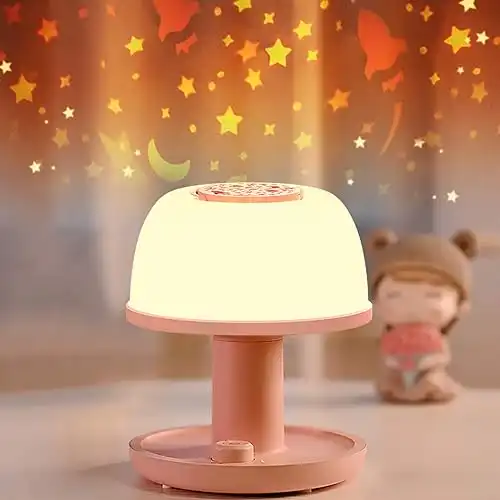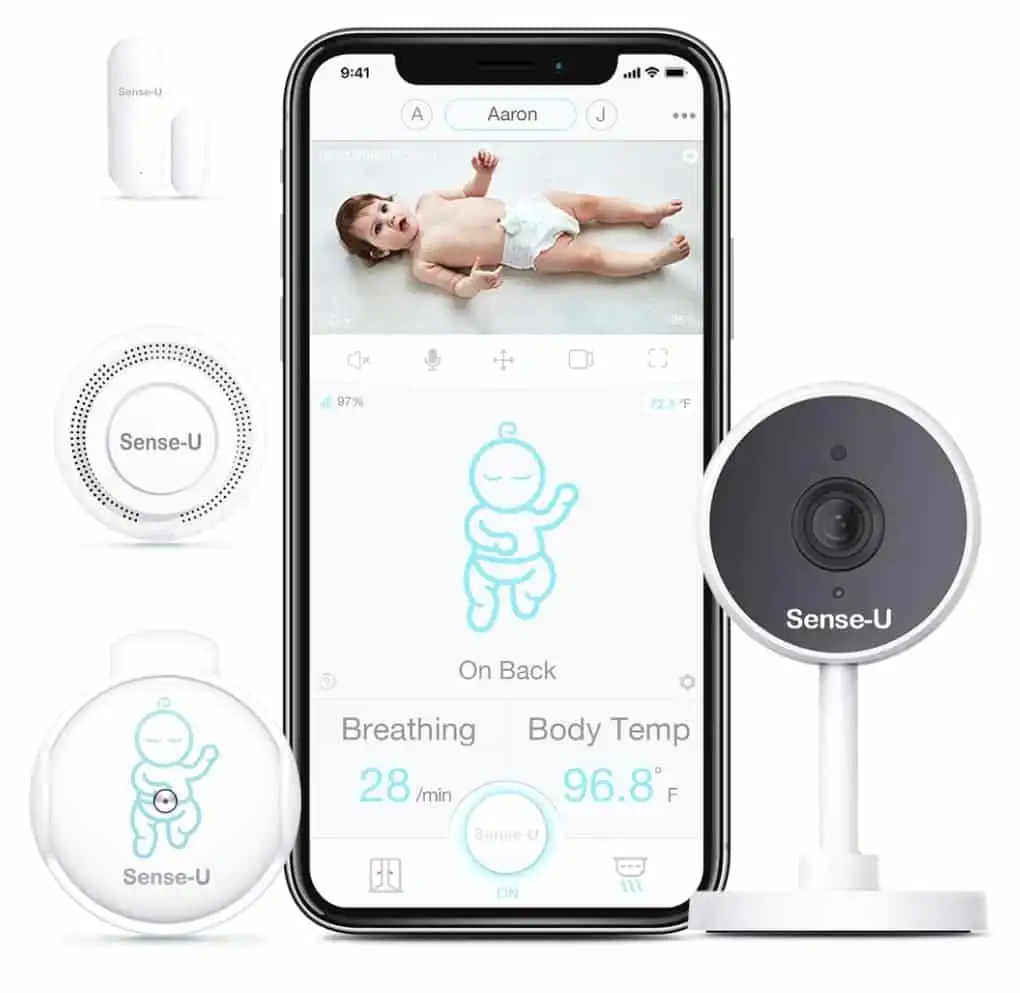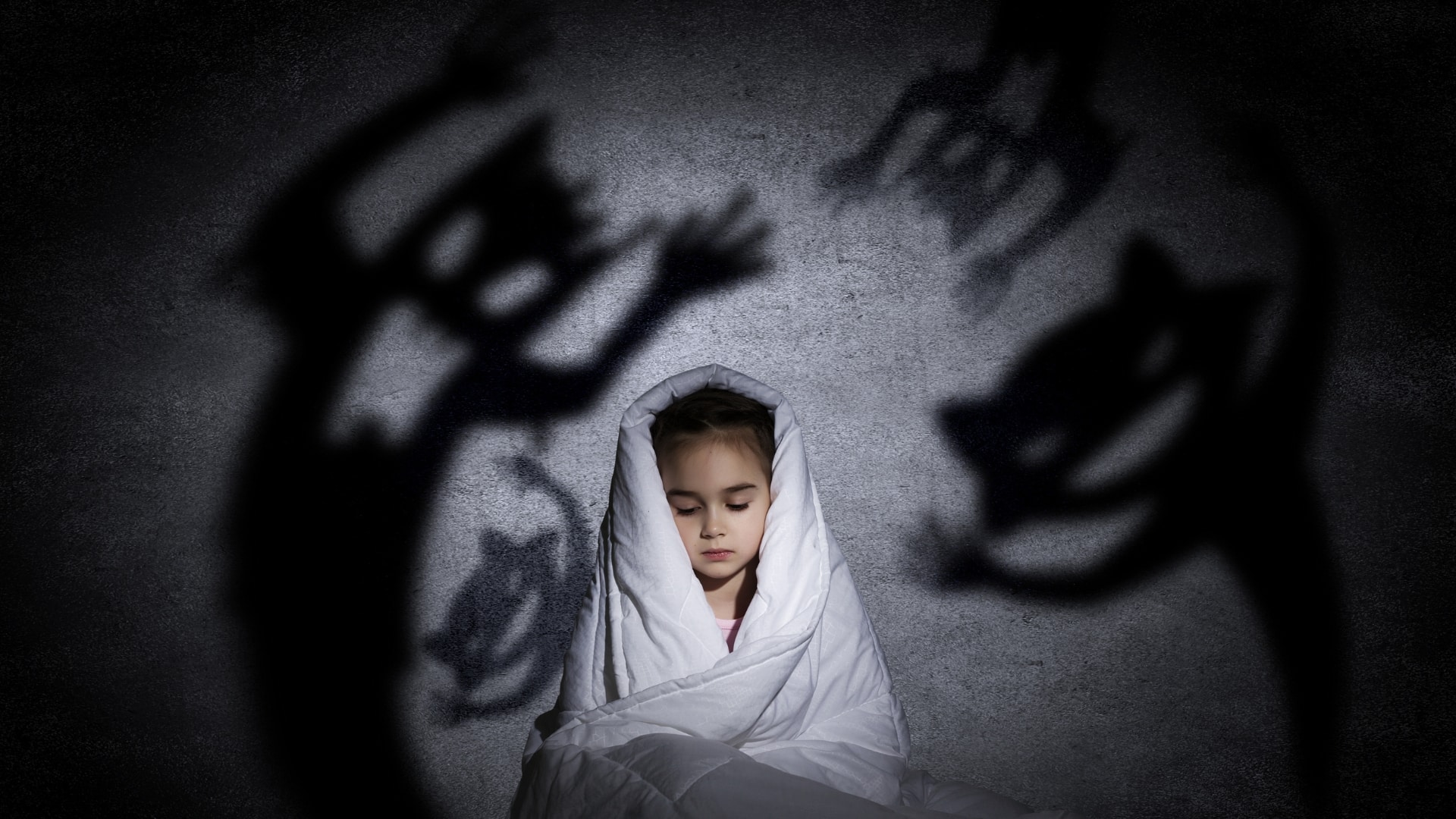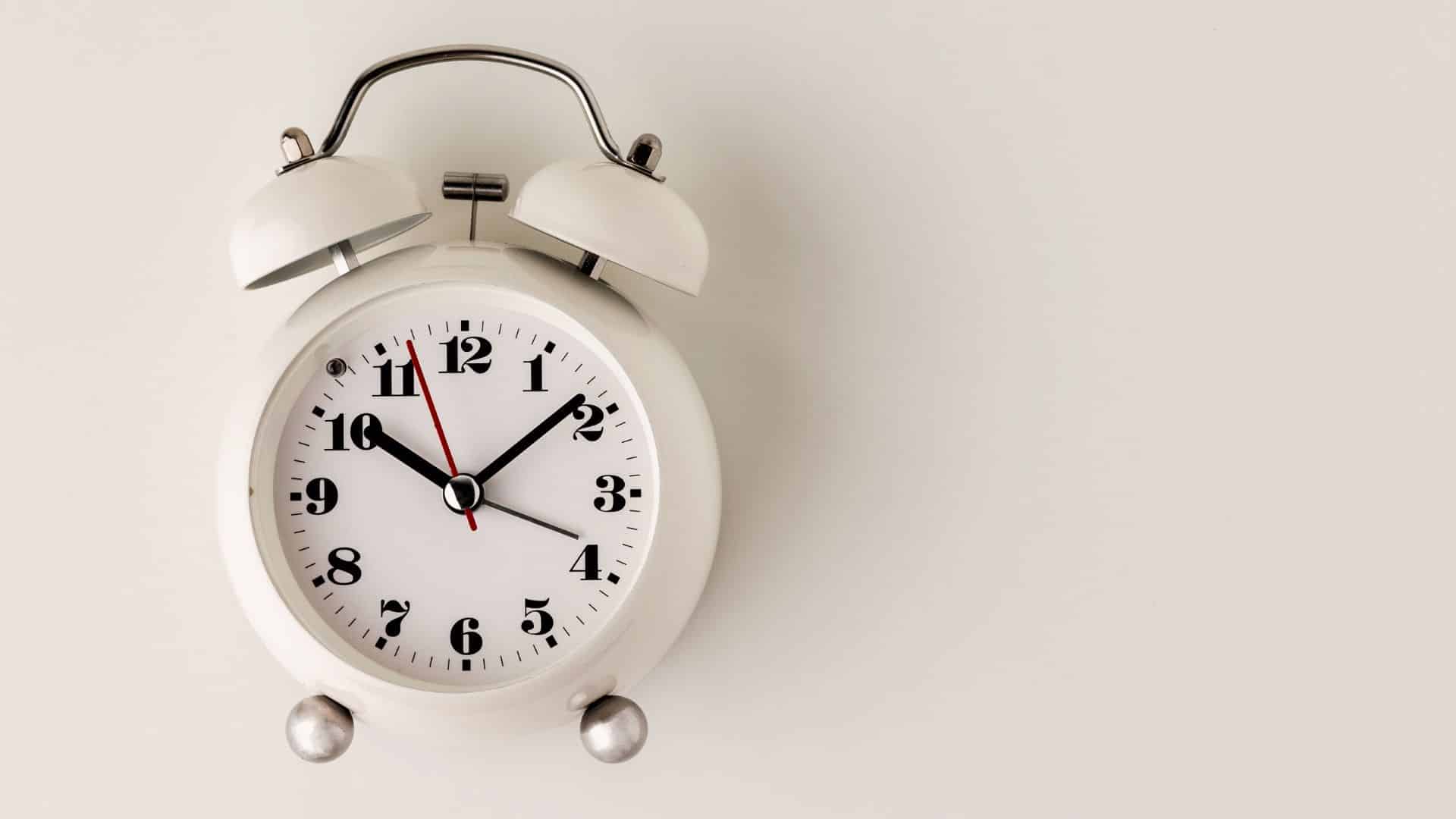Learn when to move baby to own room, signs they’re ready, and tips to make moving baby into their own room go as smoothly as possible.
When To Move Baby To Own Room
The ideal time to move your baby to their own room is usually around 6 months of age. However, there is a big debate about when is the “optimal time” to move baby to their own room.
4 Months Old
Just like adults, babies have preferences about how they sleep. And some babies will sleep a lot better in their own space. And some studies have found that babies sleep better and for longer if they are in their own room by 4 months of age.
However, it’s a very personal choice about when to move baby to own room and there’s no immediate rush.
NOTE: The following article is very interesting and a good balance to the current AAP recommendation and may help parents feel more at ease about moving their babies to their own room at 4 months: Babies Sleep Better In Their Own Rooms After 4 Months Of Age.
6 Months Old
The American Academy of Pediatrics (AAP) suggests keeping your baby in the same room but in a separate bed for at least the first 6 months… ideally, the first year, to reduce the risk of sudden infant death syndrome (SIDS) by up to 50%.
However, watching for the signs of when to move baby to own room will greatly influence your final decision and when you do make the move it is crucial that you pay attention to your baby’s sleep patterns and needs during this important milestone.
12 Months Old
Although room-sharing without bed-sharing is recommended for the first year of life by the AAP, most sleep-related death rates are highest during the first 6 months and most parents are ready to make the move before their little one’s first birthday.
NOTE: One should also take into consideration that babies moved to their own room at around 1 year of age are more likely to struggle with the transition due to increased separation anxiety which occurs naturally at this age. A lot of older babies may not want to sleep in their crib as a result.
Signs Baby Is Ready To Move To Own Room
As a parent, it can quite naturally be daunting to know when to move baby to their own room.
However, there are some staple guidelines to follow when it comes to deciding when the time is right for both you and your baby.
Take a look at the following to help you determine if your little one is prepared to make the transition.
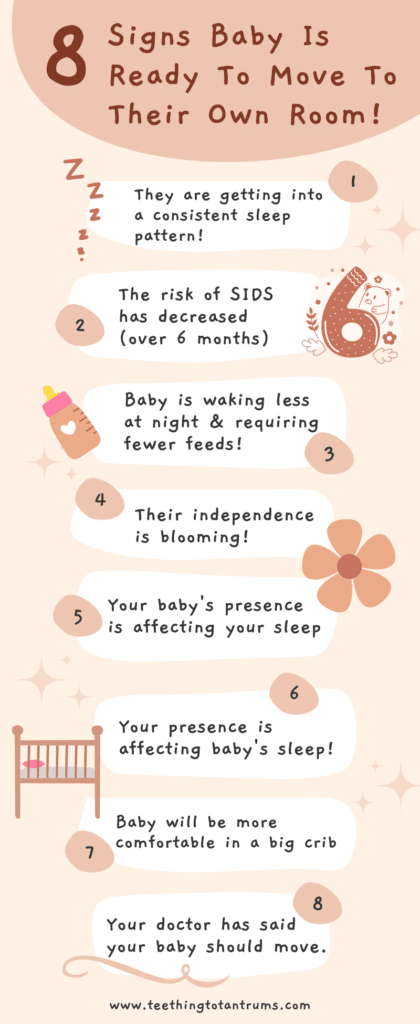
- Consistent Sleep Patterns: When your baby has established a consistent sleep routine, typically sleeping for 6 hours or more at a stretch, it may be time to consider moving them to their own room.
- Decreased SIDS Risk: As I mentioned earlier, the American Academy of Pediatrics recommends keeping your baby in your room, but not in your bed, for at least the first six months of life, to reduce the risk of Sudden Infant Death Syndrome (SIDS) by as much as 50%. If you’ve passed this milestone, you may feel more comfortable moving baby to their own room.
- Less Night Waking: If your baby is waking up less frequently during the night and having fewer night feedings and can self-soothe back to sleep, this may be a sign that they are ready for their own space.
- Increasing Independence: As your baby becomes more independent and settles quickly without your immediate presence, you may find they sleep better in their own room.
- Impact On Your Sleep: If your sleep quality is affected by sharing a room with your baby, it may be time to transition them to their own space for the benefit of the entire family.
- Impact On Their Sleep: As your baby becomes older they are more likely to be woken by ambient noise. This would include you coming to bed or just being present in the room. If your baby’s sleep is being disturbed in this way it could be a good time to make the transition to their own room.
- Baby’s Comfort: As your baby grows, so will their sleep space. If their crib no longer fits comfortably into your room, it’s time to make the move.
- Doctor’s Advice: In some cases, medical advice will make the decision for you. If your doctor has recommended your baby move into their own room, this is a surefire sign it’s time to make the transition.
Looking to get your little one to sleep quickly and effortlessly through a healthy nighttime routine? Check out my Bedtime and Nap Cheat Sheet and master the art of making daytime naps and bedtimes as seamless as possible.
A bedtime & nap cheat sheet so good your little one will ask you to put them to bed...
Laura Williams "This is a life saver! I'm so glad I downloaded your bedtime & nap cheat sheet. My little one actually asked me to put him to bed last night! Unbelievable! Thank you so much!"
Click Here For The FREE Cheat Sheet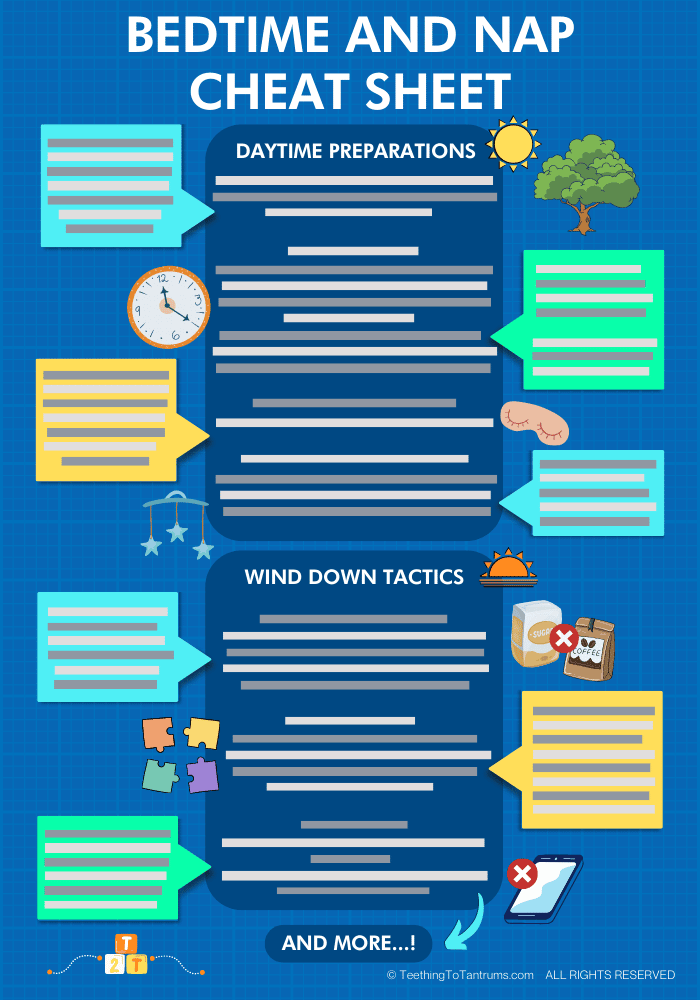
Benefits Of Baby Having Their Own Space
When it’s time for your baby to have their own room, there are several benefits to consider.
- Better Sleep: Both you and your baby can experience improved sleep quality when your baby has their own space. With fewer interruptions and disturbances, everyone gets more rest.
- Developing Independence: By giving your baby their own room, you’re helping them learn to self-soothe and gradually become more independent.
- Personal Space: As your baby grows, having their own room allows them to explore and engage with their surroundings, which can foster their cognitive and physical development.
- Routine Development: Establishing a sleep routine is easier when your baby has a consistent sleep environment.
- Privacy: Your baby’s own room offers privacy for both you and your baby, allowing for greater comfort and relaxation.
Remember, each baby is unique, and the appropriate age to move them to their own room may vary. Always prioritize their safety and well-being while making this transition.
How To Set Up Baby’s Nursery Ready For Them
When preparing a nursery for your baby, safety and comfort are key considerations.
Here are my recommendations to make baby’s room as cosy (and safe!) as possible.
- Crib Options: To start, select an appropriate crib that meets the safety standards of the Consumer Product Safety Commission (CPSC). Place the crib away from windows, heating vents, and electrical sockets to maintain a secure environment. And opt for a firm mattress that fits snugly into the crib.
- Room Temperature: Your baby’s nursery should maintain a comfortable room temperature between 68-72°F (20-22°C). Use a room thermometer to make sure baby isn’t too cold or too hot.
Offering peace of mind at a glance, the wonderful GRO-Egg changes colour with the temperature of a room. A yellow glow means a safer temperature for children to sleep in which also doubles up as a gentle nightlight for your baby!
- Bedding And Sleepwear Choices: Most importantly, limit your choice of bedding to a tightly fitted sheet, as blankets, pillows, and stuffed animals can pose a suffocation hazard. Choose appropriate sleepwear such as a sleeping sack to ensure your little one stays at the correct temperature for the time of year.
- Cosy Sleep Space: To help make their room more conducive to sleep and to prevent them from being woken by early morning sunlight install blackout blinds to control the amount of light entering the room. This will help your little one to distinguish between daytime and nighttime. And to create a soothing ambience, consider incorporating a white noise machine and a night light with a dimmer setting. These items might help settle your baby and encourage longer sleep stretches.
Finding the right night light for your child can be quite a task. You want something safe, comforting, and practical. The Cozy Starry Night Light ticks these boxes, with eye-friendly warm lighting and an easy-to-use dimmer.
Its gentle glow makes it the best night light for feeding baby, diaper changes, or comforting your little one back to sleep.
As your baby grows the Cozy Starry Night Light's starry sky projection can provide comfort and gentle quiet time stimulation. Its soft lighting ensures a dreamy, peaceful environment, supporting your baby’s natural sleep cycle.
It really is a fantastic nightlight (at a very reasonable price!)
- Eye-friendly warm lighting with adjustable brightness.
- Includes a timer function for convenience.
- Projects a starry sky that is soothing for little ones.
- Rechargeable battery, so it's very portable.
- A USB adapter is not included for charging.
- The star projector is static without motion (however, this is ideal for very young babies and toddlers).
- Battery life varies based on the brightness settings.
- Consider A Baby Monitor: Lastly, invest in a reliable baby monitor to keep tabs on your little one while they rest in their nursery. A video baby monitor offers the added benefit of visual surveillance, ensuring that your baby’s well-being remains a top priority as they transition to sleeping in their own room.
Unique easy to set up and use baby monitoring system. It even tells you what position your baby is sleeping in and monitors baby's heart rate and temperature. Comes with an easy to use App that connects to your phone with an excellent working range.
REMEMBER: You know your baby best. Trust your instincts and make the decision based on your baby’s individual needs and development. Don’t feel pressured to move them if you don’t believe they’re ready.
Tips To Make Baby’s Move Into Their Own Room As Smooth As Possible
Moving your baby into their own room is a big step for both you and your little one. Here are some tips to make this transition as smooth as possible:
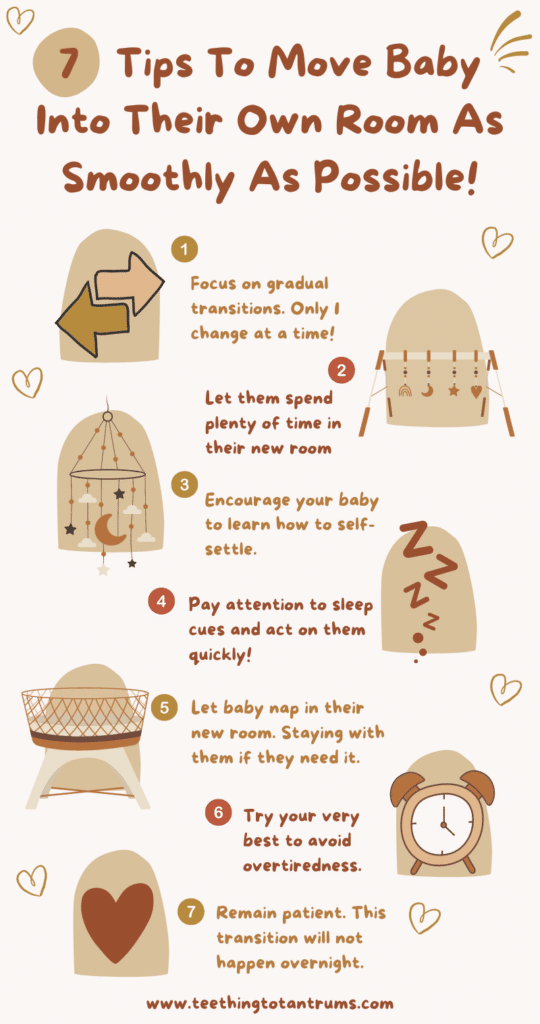
1. Focus On A Gradual Transition
Many parents make the decision to move their little one to their own room at the same time as moving them from a bassinet to a crib.
If you can avoid it… I would recommend doing one at a time.
Either move baby into a crib in your room first, letting them settle in for a few weeks and then make the move to the new room…
Or start by letting them nap in their bassinet in the new room for a few weeks, then get them sleeping in the bassinet at night in the new room BEFORE finally moving them into a crib.
This helps your baby get familiar with the space, making it easier for them. And avoids too much change happening at once!
2. Let Them Spend Time Awake In Their New Room
Put your little one in their bassinet or crib in the new room for short periods during their wake windows to allow them to get used to the new space.
This will also help with the development of their independence and ability to self-settle.
You can also encourage baby to spend time in the room away from the crib too. Simply being in their new space will help them feel more comfortable there.
3. Encourage Your Baby To Self-Soothe
Establish a consistent bedtime routine that encourages your baby to fall asleep independently.
Try to avoid feeding your baby to sleep and always put them down when drowsy and not fully asleep.
Alternative techniques like gentle rocking, soft singing, or rubbing their back to help calm them as they get used to the transition are preferable ways to settle your little one.
Read my post How To Teach Baby To Self-Soothe to learn more.
4. Pay Attention To Sleep Cues
Getting the timing right when it comes to sleep is crucial to success.
Always put your baby to bed when they’re showing signs of sleepiness, such as eye rubbing or yawning. This ensures they’re primed and ready for sleep and are more likely to settle smoothly into their new environment!
5. Let Baby Nap In New Room
Take care of the naps and the rest will follow. If your baby gets used to sleeping in their new room during the day, it’s not too much of a stretch for them to begin sleeping in there at night.
Keep things flexible in the beginning and if your little one takes to their new room straight away, great!
6. Avoid Overtiredness
Try to ensure that your little one does not get overtired as an overtired baby is less likely to embrace the transition to a new room than a well-rested one.
Overtired babies are more clingy and less likely to settle quickly.
As I mentioned above, look out for sleep cues and monitor how much sleep your little one has had over the last 24 hours.
7. Patience Is Key
Adjusting to their own room might take some time for your baby. Remember to remain patient and flexible, as your baby adapts to this change.
Keep in mind that consistency and routine are crucial for a successful transition.
By following these tips, you can help your baby adjust to their new room and create a smooth, stress-free experience for both you and your little one. Some babies will make the transition without much bother while others may need a little more time and attention.
Frequently Asked Questions About When To Move Baby To Own Room
Looking for more information about when to move baby to own room? Look no further. Here are the answers to the most frequently asked questions.
What Is The Recommended Age For Moving A Baby To Their Own Room?
I would recommend moving baby into their own room between the ages of 6 and 9 months old.
Remember, the AAP recommends that babies sleep in their parent’s room for at least the first six months to reduce the risk of Sudden Infant Death Syndrome. But any time after that is usually considered a safe time to move your baby to their own room as long as all the other guidelines on safe sleeping are followed.
When Should Baby Transition From Bassinet To Crib?
The ideal time to transition a baby from a bassinet to a crib is when they start to outgrow the bassinet, usually around 3-6 months of age. Make sure the crib meets safety standards and follows proper sleep guidelines.
What Are The SIDS Risk Factors To Consider Before Moving A Baby?
SIDS risk factors include soft bedding, overheating, and baby’s sleep position. Keeping the baby in the same room as the parents reduces SIDS risk during the first 6 months but it is crucial to follow safe sleep guidelines, regardless of room-sharing.
How Does Age Affect Baby’s Sleep Quality In A Separate Room?
Babies older than 6 months are less likely to wake up during the night, making it more manageable for them to sleep in their own room. But in all honesty, your baby’s sleep quality will be more dependent on their personality than their age and surroundings.
They may just be a light sleeper!
How Long Does The Transition Process To Their Own Room Typically Take?
The transition process varies for each baby. Some babies may adjust within a few days, while others may take a few weeks. Be patient and adjust your approach based on your baby’s needs.
Can A Baby Younger Than 6 Months Sleep In Their Own Room?
Yes, a baby younger than 6 months can sleep on their own. Whilst I recommend moving them between 6 and 9 months of age, if you do choose to move them earlier, I would highly recommend using a baby monitor (video and sound) so you can keep tabs on your little one and of course, always follow safe sleep guidelines.
Can A 1 Year Old Sleep In Their Own Room?
Yes, a 1-year-old can sleep in their own room. At this age, the risk of SIDS is significantly reduced. Ensure you continue to follow safe sleep practices and create a comfortable, consistent bedtime routine.
Do Babies Sleep Better On Their Own?
Some babies sleep better on their own, while others may take time to adjust. If you feel you are disturbing your baby’s sleep, for instance, it is probably the right time to make the move. Pay attention to your baby’s sleep habits and preferences to make the best decision for you and for them.
Need More Parenting Help?
- Download our FREE Perfect Sleep Cheat Sheet. It’s a free, easy-to-use and proven formula designed for parents of 0-5 year olds to master the art of consistently undisturbed and restful sleep without the yelling, nagging or exhausting long-winded evenings.
- Check out our Parenting Toolbox. You’ll get access to expertly-chosen products that you can guarantee are the best for your little one and your wallet.
- Ready to create the calm, peaceful evenings you deserve? Then checkout our most popular course - The Bedtime Battles Masterclass

A bedtime & nap cheat sheet so good your little one will ask you to put them to bed...
Laura Williams "This is a life saver! I'm so glad I downloaded your bedtime & nap cheat sheet. My little one actually asked me to put him to bed last night! Unbelievable! Thank you so much!"
Click Here For The FREE Cheat Sheet

